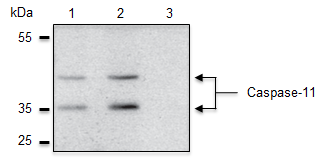anti-Caspase-4/11 (p20) mAb (Flamy-1)
| Code | Size | Price |
|---|
| AG-20B-0060-C100 | 100 ug | £300.00 |
Quantity:
Prices exclude any Taxes / VAT
Overview
Antibody Clonality: Monoclonal
Regulatory Status: RUO
Target Species:
- Human
- Mouse
Applications:
- Immunoprecipitation (IP)
- Western Blot (WB)
Shipping:
Blue Ice
Storage:
-20°C
Images
Documents
Further Information
Alternate Names/Synonyms:
Caspase-11 (mouse); Caspase-4 (human); ICE(rel)-II (human); Protease ICH-2 (human); Protease TX (human); Protease ICH-3 (mouse)
Concentration:
1mg/ml
EClass:
32160000
Form (Short):
liquid
Formulation:
Liquid. In PBS containing 10% glycerol and 0.02% sodium azide.
Handling Advice:
After opening, prepare aliquots and store at -20°C.Avoid freeze/thaw cycles.
Immunogen:
Recombinant mouse Caspase-11 (aa 81-373).
Long Description:
Monoclonal Antibody. Recognizes endogenous full-length protein and activated (p20) fragment of mouse and human caspase-4/11. Isotype: Mouse IgG2bkappa. Clone: Flamy-1. Applications: IP, WB. Liquid. In PBS containing 10% glycerol and 0.02% sodium azide. Inflammatory caspases (also known as group I caspases) are encoded by three main genes in humans, caspase-1, caspase-4 and caspase-5 and three main genes in mouse, caspase-1, caspase-11 and caspase-12. Caspase-11 is the murine orthologue of human caspase-4 and -5. Murine caspase-11 is a poorly characterized member of the caspase-1 subfamily. Caspase-11-deficient embryonic fibroblasts are resistant to apoptosis induced by ectopic expression of caspase-1, suggesting that caspase-11 is an upstream activator of caspase-1. Unlike caspase-1, the expression of caspase-11 is LPS-inducible and it is reasonable to postulate that other members of the family are regulated at the transcriptional or translational level by extracellular stimuli. Recently caspase-11 has been shown to be required for activation of the Nlrp3 inflammasome upon E. coli, V. cholerae and C. rodentium infection. The upstream activators of caspase-11 are TLR4 and TRIF, that modulate enteropathogen-induced inflammasome activation by promoting caspase-11 expression and activation. Formation of ASC foci (specks), a measure of NLRP3/ASC complex formation, requires caspase-11 but not caspase-1 indicating that caspase-11 acts upstream of the NLRP3/ASC complex.
NCBI, Uniprot Number:
P70343
Package Type:
Plastic Vial
Product Description:
Inflammatory caspases (also known as group I caspases) are encoded by three main genes in humans, caspase-1, caspase-4 and caspase-5 and three main genes in mouse, caspase-1, caspase-11 and caspase-12. Caspase-11 is the murine orthologue of human caspase-4 and -5. Murine caspase-11 is a poorly characterized member of the caspase-1 subfamily. Caspase-11-deficient embryonic fibroblasts are resistant to apoptosis induced by ectopic expression of caspase-1, suggesting that caspase-11 is an upstream activator of caspase-1. Unlike caspase-1, the expression of caspase-11 is LPS-inducible and it is reasonable to postulate that other members of the family are regulated at the transcriptional or translational level by extracellular stimuli. Recently caspase-11 has been shown to be required for activation of the Nlrp3 inflammasome upon E. coli, V. cholerae and C. rodentium infection. The upstream activators of caspase-11 are TLR4 and TRIF, that modulate enteropathogen-induced inflammasome activation by promoting caspase-11 expression and activation. Formation of ASC foci (specks), a measure of NLRP3/ASC complex formation, requires caspase-11 but not caspase-1 indicating that caspase-11 acts upstream of the NLRP3/ASC complex.
Purity:
>95% (SDS-PAGE)
Source / Host:
Purified from concentrated hybridoma tissue culture supernatant.
Specificity:
Recognizes endogenous full-length protein and activated (p20) fragment of mouse and human caspase-4/11. Does not detect human Caspase-5.
Transportation:
Non-hazardous
UNSPSC Category:
Primary Antibodies
UNSPSC Number:
12352203
Use & Stability:
Stable for at least 1 year after receipt when stored at -20°C.
References
NLRP3 inflammasome activation downstream of cytoplasmic LPS recognition by both caspase-4 and caspase-5: P.J. Baker, et al.; Eur. J. Immunol. 45, 2918 (2015) | Generation of Genetic Knockouts in Myeloid Cell Lines Using a Lentiviral CRISPR/Cas9 System: P.J. Baker & S.L. Masters; Methods Mol. Biol. 1714, 41 (2018) | Intestinal restriction of Salmonella Typhimurium requires caspase-1 and caspase-11 epithelial intrinsic inflammasomes: S.M. Crowley, et al.; PLoS Pathog. 16, e1008498 (2020) | STING regulates metabolic reprogramming in macrophages via HIF-1alpha during Brucella infection: M.T.R. Gomes, et al.; PLoS Pathog 17, e1009597 (2021)



